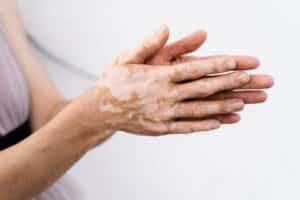Vitiligo Treatment in Tampa & Dade City, FL

At Florida Westcoast Skin and Cancer Center, we understand the emotional effect that vitiligo can have, even though it isn’t a medically serious condition.
This chronic skin disorder, which causes areas of skin to lose pigment, impacts between one-half and two percent of the global population (according to the Journal of Advances in Medicine and Medical Research). For many, the visible contrast between affected and unaffected skin can lead to self-consciousness or frustration.
Our team of board-certified dermatologists offers compassionate care and a range of clinical treatment options to reduce the appearance of vitiligo and support your skin health. We’re here to help you feel more comfortable in your own skin.
What Is Vitiligo?
Vitiligo is a condition caused by progressive depigmentation. It presents as white patches on the skin.
Although it can develop on any body part, vitiligo is usually found on the face, elbows, knees, hands, feet, genitals, and upper thighs. The texture of the depigmented skin is not altered, and the condition is not painful, although the affected skin may be much more sensitive to the sun and prone to sun damage.

Vitiligo appears on both sides of the body equally, often symmetrically, and the borders of the white patches are irregular but well-defined. White patches may show up gradually or suddenly.
Causes of Vitiligo
Vitiligo is an autoimmune disorder in which immune cells attack melanocytes, the cells that produce pigment. Why this happens is not yet known.
Vitiligo runs in some families, can appear at any age, affects both sexes equally, and impacts people of every skin color. There is also some correlation between vitiligo and other conditions like pernicious anemia, hyperthyroidism, and Addison's disease.
Diagnosis of Vitiligo
In most cases, vitiligo is diagnosed by a simple physical examination. Sometimes, though, an ultraviolet light called Wood's light is used. Wood's light provides a definitive diagnosis because it illuminates only the skin with vitiligo.
Sometimes, a skin biopsy is taken to ensure the depigmentation has no other cause. If another medical issue is suspected, blood tests may be administered to check the patient's levels of various hormones, especially thyroid hormone, and vitamin B12.
Treatment of Vitiligo
Several treatments for vitiligo can be used with varying degrees of success. They include:
- Phototherapy (medical exposure to ultraviolet light)
- Topical drugs (to increase skin sensitivity to light)
- Topical corticosteroids
- Topical immunosuppressants
- Autologous skin grafts from pigmented areas
- Medical tattooing (micropigmentation)
Other treatments are being used experimentally, such as transplanting melanocytes grown from a patient's healthy cells to the area affected with vitiligo.
Why Choose Florida Westcoast Skin and Cancer Center?
Florida Westcoast Skin and Cancer Center provides trusted, individualized care for vitiligo under the guidance of board-certified dermatologists.
Dr. Michael A. Scannon has been practicing in Tampa and Dade City since 1982, with dermatology training from Emory University and internal medicine education from the University of South Florida. His professional memberships and academic affiliations reflect his longstanding commitment to skin health.
Working alongside Dr. Scannon is Dr. Stefanie Altmann, a board-certified dermatologist specializing in cosmetic, surgical, and clinical dermatology. Together, they offer patients thoughtful care backed by advanced techniques and years of clinical experience in treating diverse skin conditions.
FAQs
Is Vitiligo Contagious?

While the appearance of white patches may raise questions or concerns, there is no risk of transmission to others. Educating others is important to reducing stigma and misconceptions about the condition.
Are There Any Lifestyle Changes That Help Manage Vitiligo?
There’s no cure for vitiligo. However, certain lifestyle habits can manage symptoms and support skin health:
- Protecting skin from sunburn with broad-spectrum sunscreen and protective clothing.
- Reducing stress, as stress may influence immune function.
- Eating a balanced diet and staying hydrated.
- Avoiding skin trauma – cuts, burns, or friction – to reduce the risk of new patches forming (a phenomenon known as the Koebner effect).
- Following your dermatologist’s guidance and maintaining consistent routines.
Is Vitiligo Linked To Other Health Problems or Autoimmune Diseases?
Yes, vitiligo is often associated with other autoimmune conditions.
Not everyone with vitiligo will develop another health issue. However, studies like this one, published in Frontiers in Endocrinology, show a higher prevalence of autoimmune thyroid disease (like Hashimoto’s thyroiditis or Graves’ disease) among those with vitiligo. Other possible connections include type 1 diabetes, rheumatoid arthritis, lupus, and alopecia areata.
Routine checkups and blood work can help detect related conditions early. This is especially helpful if you experience other symptoms like fatigue, weight changes, or joint pain in addition to skin changes.
Can Makeup or Self-Tanners Help Cover Vitiligo Spots?
Yes, you can use both makeup and self-tanners to cover areas of vitiligo temporarily.
Specialized camouflage makeup is available in waterproof, long-lasting formulas that match various skin tones and are often recommended for daily use or special occasions. Self-tanners, especially those with a buildable tint, can also help create a more even appearance without sun exposure.
Keep in mind that these options do not treat vitiligo. However, they can boost confidence for people who prefer to mask the contrast in pigmentation. Ultimately, it’s a personal choice. Some choose to cover the patches, while others embrace their skin’s natural appearance.
Does Vitiligo Change Hair Color?
Vitiligo can affect both the skin and hair.
When the condition impacts areas with hair follicles – such as the scalp, eyebrows, eyelashes, or beard – the lack of melanin may cause the hair to turn white or gray in those patches. This change happens because the same pigment-producing cells responsible for skin color also influence hair color.
Not everyone with vitiligo will notice changes in their hair, and the extent varies from person to person. Hair regrowth in affected areas may remain white, though some treatments aim to restore pigmentation in both skin and hair over time.
Contact Us In Tampa & Dade City
If you're looking for vitiligo treatment in the Tampa or Dade City areas, the board-certified dermatologists at Florida Westcoast Skin and Cancer Center can help. Call us today at 813-877-4811 (Tampa) or 352-567-3563 (Dade City) or reach out online to schedule an appointment.
